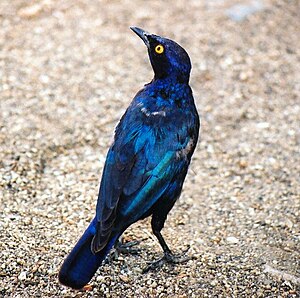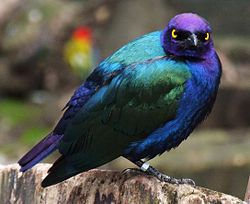Real star stars
| Real star stars | ||||||||||||
|---|---|---|---|---|---|---|---|---|---|---|---|---|

Red shoulder gloss star ( Lamprotornis nitens ) |
||||||||||||
| Systematics | ||||||||||||
|
||||||||||||
| Scientific name | ||||||||||||
| Lamprotornis | ||||||||||||
| Temminck , 1820 |
The actual glossy starlings ( Lamprotornis ) from the species-rich family of starlings (Sturnidae) are a genus of passerine birds (Passeriformes) widespread in sub-Saharan Africa . At least 22 species that draw attention to themselves with their particularly iridescent metallic sheen are currently included in the genus Actual glossy starlings . They feed mostly on insects and fruits and are mostly very sociable birds.
features
The genus of the common starling includes a wide range of small to large species from the starling family. The smallest and probably lightest type of the actual glossy starlings is the Fischerglanzstar ( Lamprotornis fischerii ) with 17.5 to 19 cm in length and a weight of about 46 grams and is also one of the smallest and lightest within the starling family. In contrast, the long-tailed glossy star ( Lamprotornis caudatus ) with a length of up to 54 cm, of which about 60% is accounted for by the tail, is not only the longest among the actual glossy starlings, but also within the family of starlings. The heaviest of the actual glossy starlings is the magnificent starling ( Lamprotornis splendidus ) with a weight of up to 150 grams and an average weight of about 133 grams.
plumage
The plumage is mostly in blue, greenish and purple and often very shiny colors, which in some cases contain black elements. Two types are completely gray or brown-white, such as the gray gloss star ( Lamprotornis unicolor ) and the two-color gloss star ( Lamprotornis bicolor ). In some species, the chest and / or abdominal area are kept in white, yellow, red to red-brown tones, as in the Hildebrandt gloss star ( Lamprotornis hildebrandti ).
The special thing about the actual glossy starlings is, as their name suggests, the special, strongly iridescent, metallic sheen. The shine ranges from a slightly metallic, shiny color, as in the case of the gray sheen star, to strongly shimmering metallic, shiny colors. This shine is produced in four different ways in starlings (Sturnidae), of which only two come into play with the actual glossy starlings. One shape consists of hollow melanosomes within the melanocytes , which cause strong optical refraction at the interfaces between the air and the melanin . The relationship between the melanosomes also influences the color. The other form consists of a combination of the previously mentioned hollow melanosomes and thinner and more densely packed or multi-layered melanosomes in platelet form, which influence the coloration by single-layer, multi-layered and alternating (alternating or alternating) melanosomes. It should be noted that there is only one of these forms per species.
eyes
The eyes of most species are either yellowish-orange, matt black or whitish-yellow and disproportionately large, which gives the viewer the feeling of a stern look.
The starlings as well as the common starlings and most other bird species, apart from the nocturnal birds, see their environment differently than we humans. In contrast to humans, the star has four and not only three types of photoreceptors (also called photoreceptors ) on the retina . In addition to the thinner rod-shaped receptors responsible for black and white vision, four cone-shaped receptor types are responsible for perception in starlings (tetrachromatic vision). Three of the four cone-shaped receptor types are responsible for the area of light that is visible to humans (trichromatic vision), which make the three primary colors red, green and blue visible. The fourth receptor is responsible for the perception in the area of ultraviolet light , which is not visible to humans. The incidence of light stimulates the various types of receptors within the strongly folded membranes, which are provided with different colored oil droplets, with different intensities. The responsible receptors react more or less strongly to the different wavelengths of light, so that the different colors and hues are perceived. The additional UV receptor compared to humans allows starlings to perceive our environment in a much more differentiated or different way than it appears to humans. With the help of the UV receptors, the star is able to better and more easily recognize differences in other conspecifics, the ripeness of the fruit or traces that we cannot see.
Lifestyle and diet
The actual glossy starlings usually feed on insects that they peck from the ground, as well as smaller fruits from trees and bushes, seeds or nectar. Individual species have also developed food residues from humans as an additional source of food, as is the case, for example, with the red-shouldered gloss star.
The couples are usually monogamous and only look for a new one after losing their partner. The starlings are sociable birds and usually live in larger groups outside of the breeding season. Depending on the species, they often move around in swarms of hundreds or more specimens. Flocks of up to 10,000 or more birds have been reported.
species
- Giant gloss star ( Lamprotornis australis )
- Long-tailed gloss star ( Lamprotornis caudatus )
- Tail Glanzstar ( Lamprotornis purpuropterus )
- Mevesglanzstar ( Lamprotornis mevesii )
- Gray gloss star ( Lamprotornis unicolor )
- Green-tailed starling ( Lamprotornis chalybaeus )
- Schillerglanzstar ( Lamprotornis iris )
- Red shoulder gloss star ( Lamprotornis nitens )
- Enlightenment star ( Lamprotornis chalcurus )
- Purpurglanzstar ( Lamprotornis purpureus )
- Wedge-tailed gloss star ( Lamprotornis acuticaudus )
- Brass star ( Lamprotornis chloropterus )
- Fischerglanzstar ( Lamprotornis fischerii )
- White-headed gloss star ( Lamprotornis albicapillus )
- Two-colored gloss star ( Lamprotornis bicolor )
- Red-bellied gloss star ( Lamprotornis pulcher )
- Tricolor gloss star ( Lamprotornis superbus )
- Royal shine star ( Lamprotornis regius )
- Magnificent Star ( Lamprotornis splendidus )
- Prinzenglanzstar ( Lamprotornis ornatus )
- Hildebrandt gloss star ( Lamprotornis hildebrandti )
- Shelley gloss star ( Lamprotornis shelleyi )
Systematics
The 22 species can be divided into four main groups. The sister species Hildebrandt- ( L. hildebrandti ) and Shelleyglanzstar ( L. shelleyi ) form a basal group , they form the sister clade to the rest of the genus. Within the remaining crown group , the family tree of the actual glossy starlings branches into the species australis , caudatus , purpuropterus , mevesii and unicolor . This group is opposed to a clade, which in turn is divided into the subgroups chalybaeus , iris , nitens , chalcurus , purpureus , acuticaudus and chloropterus or fischerii , albicapillus , bicolor , pulcher , superbus , regius , splendidus , and ornatus .
The International Ornithologists' Committee was mainly responsible for shifting species to other starling genera in 2008 and 2009 on the basis of sequential genetic analyzes by Lovette and Rubenstein. The genera Spreo ( S. bicolor , S. fisherii and S. albicapillus ) and Coccycolius ( C. iris ) were assigned to the genus Lamprotornis on the basis of these mtDNA analyzes . On the other hand, three Lamprotornis species ( L. corruscus as well as L. purpureiceps and L. cupreocauda ) are no longer counted among the real starlings on the basis of these analyzes, but are placed in the new genera Notopholia and Hylopsar .
The following family tree shows the relationships of the genus Lamprotornis based on molecular genetic studies of mitochondrial and nuclear DNA:
| Lamprotornis |
|
||||||||||||||||||||||||||||||||||||||||||||||||||||||||||||||||||||||||||||||||||||||||||||||||||||||||||||||||||||||||||||||||||||
|
|
literature
- IJ Lovette, DR Rubenstein 2007: A comprehensive molecular phylogeny of the starlings (Aves: Sturnidae) and mockingbirds (Aves: Mimidae): Congruent mtDNA and nuclear trees for a cosmopolitan avian radiation. In: Molecular Phylogenetics and Evolution. 44, No. 3, pp. 1031-1056. Elsevier, September 2007, DOI: 10.1016 / j.ympev.2007.03.017 . ( online PDF ( memento from June 27, 2010 in the Internet Archive ), accessed on March 22, 2015.)
- CH Fry, S. Keith and EK Urban (Eds) (2000). The birds of Africa Vol. VI , Academic Press, London. P. 593.
- F. Gill, D. Donsker: IOC World Bird List. (v 5.1). doi : 10.14344 / IOC.ML.5.1 2015.
- Rafael Maia, Dustin R. Rubenstein and Matthew D. Shawkey in: "Key ornamental innovations facilitate diversification in an avian radiation". Biological Sciences - Evolution: PNAS 2013 110 (26) 10687-10692; published ahead of print June 10, 2013, doi : 10.1073 / pnas.1220784110 . Full text . Retrieved March 26, 2015.
- Frederike Woog Seeing and being seen - color vision of birds in: Der Falke - Journal für Vogelbeobachter 5/2009. ( [3] . Retrieved on July 11, 2015.)
- GE Hill & KJ McGraw (Eds, 2006): Bird Coloration. Vol. 1: Mechanisms and Measurements; Vol. 2: Function and Evolution .
Individual evidence
- ↑ a b c Fry, CH, Keith, S. and Urban, EK (Eds) (2000). The birds of Africa Vol. VI, Academic Press, London.
- ↑ Rafael Maia, Dustin R. Rubenstein and Matthew D. Shawkey in: Key ornamental innovations facilitate diversification in an avian radiation ; Biological Sciences - Evolution: PNAS 2013 110 (26) 10687-10692. [1]
- ↑ Frederike Woog Seeing and being seen - color vision of birds in: Der Falke - Journal für Vogelbeobachter 5/2009. [2]
- ^ A b c Irby J. Lovette, Dustin R. Rubenstein 2007: A comprehensive molecular phylogeny of the Starlings and Mockingbirds - Congruent mtDNA and nuclear trees for a cosmopolitan avian radiation. ( Memento of June 27, 2010 in the Internet Archive ) on columbia.edu, 2015. Retrieved March 22, 2015.
- ↑ Gill, F&D Donsker (Eds). 2015. IOC World Bird List (v 5.1).
Web links
- The Internet Birds Collection - Real glossy starlings ( Lamprotornis ). [4]




